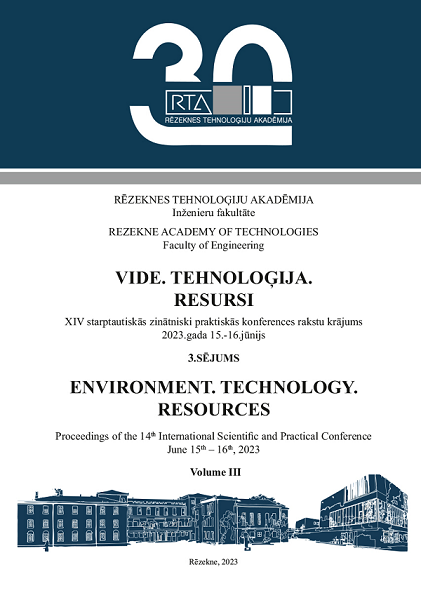INCREASING THE QUALITY OF FORMING OF SPINNING DETAILS OF ALUMINUM ALLOYS BY CONTROLLING THE RESIDUAL STRESSES IN THEIR SURFACE LAYER
DOI:
https://doi.org/10.17770/etr2023vol3.7211Keywords:
non-destructive method, residual stresses, resistive method, spinning (cold flow turning)Abstract
In the article are analyzed the effect of technological modes and processing parameters on the stress of spinning (cold flow turning) details of aluminum alloys. Аs the object of the study was used a detail of aluminum alloy AMg5, obtained after 3-stage spinning with intermediate heat treatments between the stages. As a control criterion was used non-destructive resistive electro contact method, based on the correlation between the integral electric and mechanical characteristics of metals and alloys – specific conductivity or electrical resistivity within the h-layer of the metal and the amount of deformation in the crystal lattice of the material due to the residual stresses.
References
A.Y. Ivanov, D.B. Leonov. Analysis of the methods for control and measurement of residual stress // Journal of the Technical University - Sofia, Plovdiv branch, Bulgaria «Fundamental Sciences and Applications», 2012, Volume 17. pp. 13–19.
A.Y. Ivanov, D.B. Leonov. Technological methods of providing product quality, Scientific and technical journal of SPbGU ITMO, 2011, No. 5(75), pp. 111 – 113 (in Russian).
S.P. Burkin. Residual stresses in metal products: textbook. Yekaterinburg: Publishing House of the Ural University, 2015. p. 12 (in Russian).
V.F. Bezyazychny, R.N. Fomenko. Technological support of the operational properties of gas turbine engine parts // Journal of Metalworking, Politechnika Publishing House. 2017. No. 1. pp. 16–22 (in Russian).
V.S. Mukhin. Surface. Technological aspects of the strength of GTE parts. M., 2005. p.295.
V.A. Valetov, S.D. Vasilkov, O.S. Yulmetova. Methods of researching the characteristics of the surface layer of device parts, Teaching manual, St. Petersburg, 2010 (in Russian).
A.D. Ilyina. Resistive electrocontact method for determining residual stresses in parts after machining. Young Scientists Forum.-2022, No. 5(69), 2019, pp. 145-148 (in Russian).
D.B. Leonov, A.Y. Ivanov. Control of residual stresses during spinning of aluminum alloy parts // Proceedings from the "Jubilee Scientific Conference on the occasion of 10 years since the establishment of the NVU". - Volume 7., V. Tarnovo, 2012,pp. 120–126 (in Bulgarian).
D.V. Dudka, V.I. Tregubov. Influence of technological parameters on flow formation during rotational spinning of axially symmetric parts, News of Tula State University, TulSU Publishing House, 2011, pp. 3 – 13 (in Russian).
P.M. Vinnik, T.V. Vinnik, A.I. Olehver, A.Y. Remshev. Calculation of the influence of material hardening on stresses and formed mechanical properties during successive drawings with wall thinning. Metalworking, No. 1, 2019, p. 30-34.
V.M. Kishurov, N.K. Krioni, V.V. Postnov, P.P. Chernikov, M.V. Kishurov. Processes of forming parts in mechanical engineering: textbook. M.: Journal of Mechanical Engineering, 2015. p. 496.
A. S. Chumadin1 , D.A. Baturin1. Modeling and control of the Springback Effect in the Bottom Sheet Metal Part One stage Drawing Process. Science and Education of the Bauman MSTU, 2014, no. 9, pp. 106–118.
RDMU 109-77. Method of selection and optimization of controlled parameters of technological processes. Introduction 07/01/1978. M, Standards Publishing House, 1978, p. 48 (in Russian).
D.V. Vasilkov, S.D. Vasilkov, A.V. Nikitin. Measurement of residual stresses by the resistive electrocontact method // Journal of Metalworking. 2017. No. 6. pp. 30–34.
D.V. Vasilkov, D. A. Mezentsev, A. V. Nikitin [et al.] Technological residual stresses and their deforming ability during cutting //Journal of Metalworking. 2018. No. 4. pp. 2–6.
G.V. Muratkin. Processes of formation and reduction of technological residual deformations of non-rigid parts // Journal of Metalworking. 2019. No. 6. pp. 17–26.
Saha S. Non-Destructive Evaluation of Residual Stresses in Welding. 2022. DOI: http://dx.doi.org/10.5772/intechopen.101638.
Suvi-Santa-aho, Laitinen A, Sorsa A, Vippola M. Barkhausen noise probes & modelling: A review. Journal of Nondestructive Evaluation. 2019;38(4): 2-4.
A.H. Mahmoudi, A. Ghasemi, G.H. Farrahi, K.A. Sherafatnia. Comprehensive experimental and numerical study on redistribution of residual stresses by shot peening // Materials & Design. 2016. N 90. P. 478–487.
N.N. Stolyarov, A.D. Sukhikh, M.V. Tabanyukhova, Residual Stresses in 3D-Printed Models. Proceedings of the Novosibirsk State University of Architecture and Civil Engineering (Sibstrin), 24-1/2(79/80) 48-54 (2021).
M. Tabanyakhova, , N. Slolyarov, A. Nagel, The issue of residual stresses in Additive Technologies. MATEC Web of conferences, Volume 376, AMEFP 2022, DOI: https://doi.org/10.1051/matecconf/202337601008.
G.V. Samandasyuk, I.A. Slesarev, M.S. Kozhen, Additive Technologies in Construction. Globe: Engineering Sciences 2(33) 18-1 (2020).
A.D. Sukhikh, N.N. Stolyarov, M.V. Tabanyukhova, The Issue of Residual Stresses in 3D-Printed Models. In the coll.: The Intellectual Potential of Siberia. Collection of Scientific Papers of the 29thRegional Scientific Student Conference dedicated to the Year of Science and Technology in Russia. In 5 Parts. Ed. D.O. Sokolova, Novosibirsk, 88-92 (2021).



